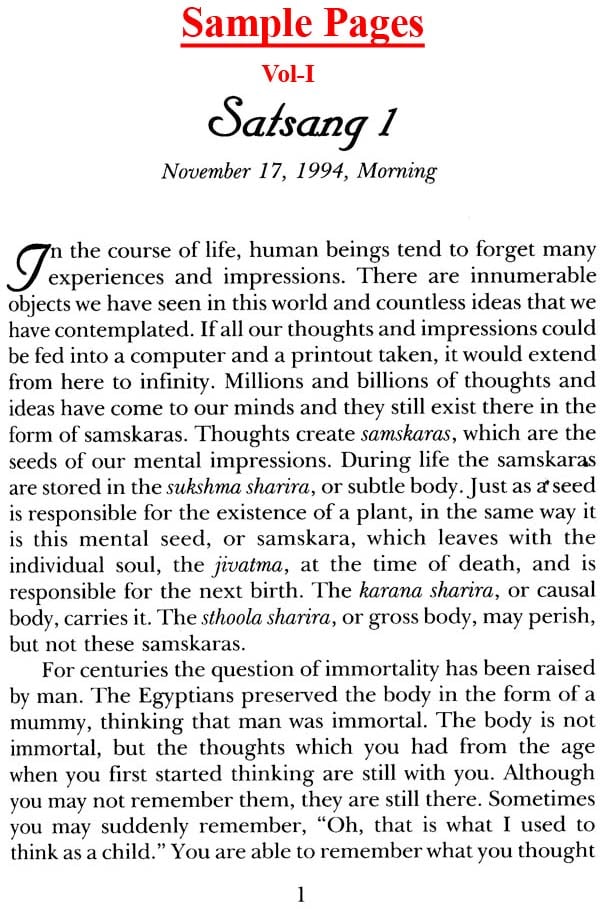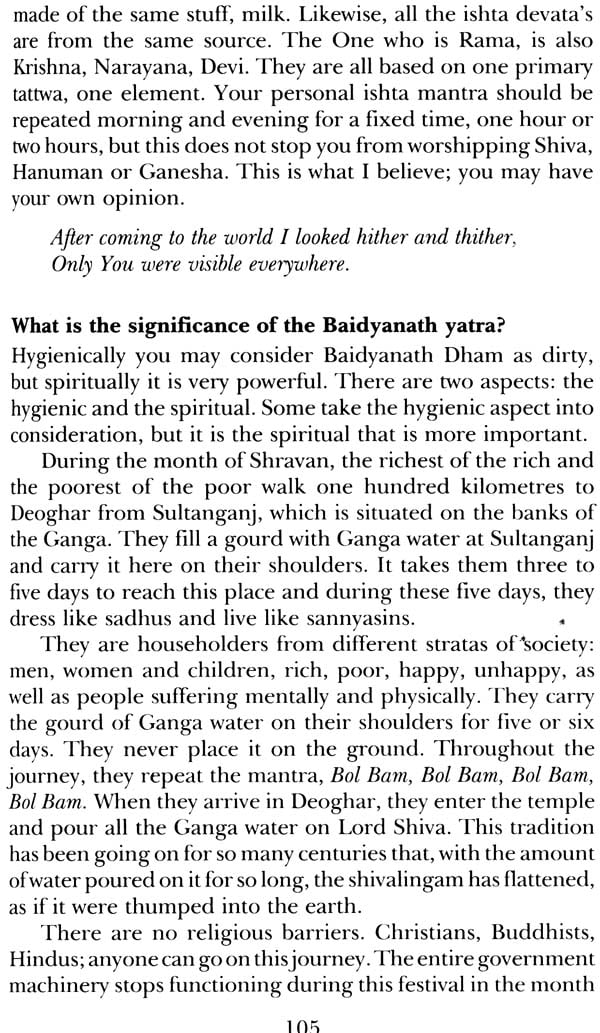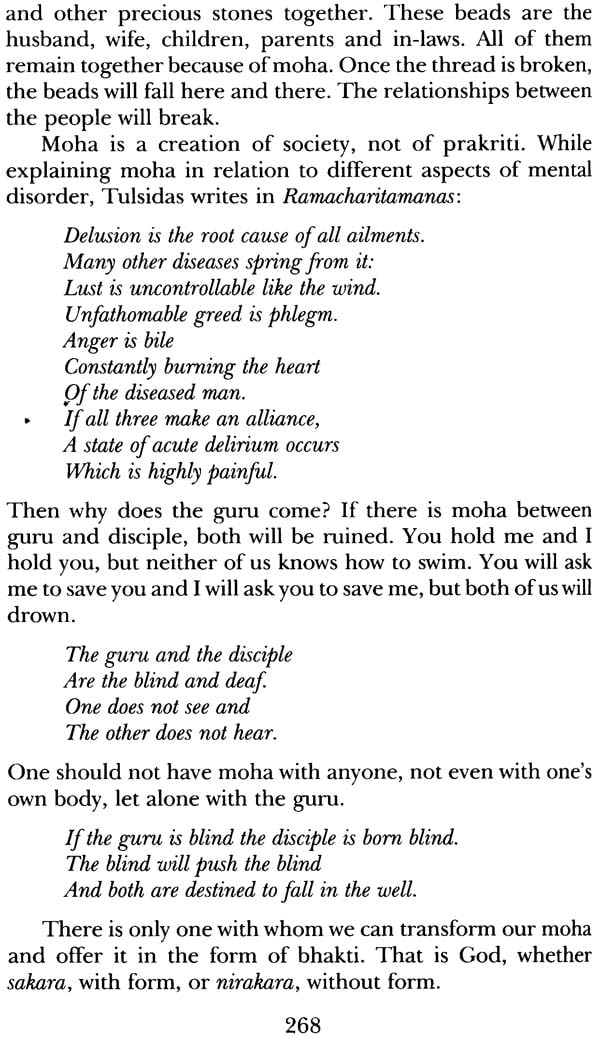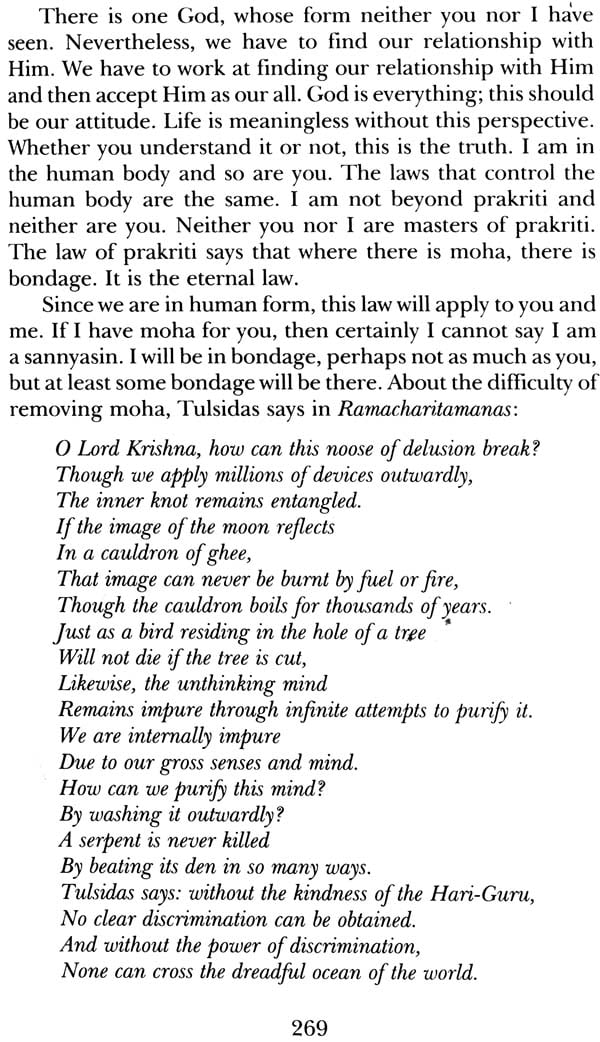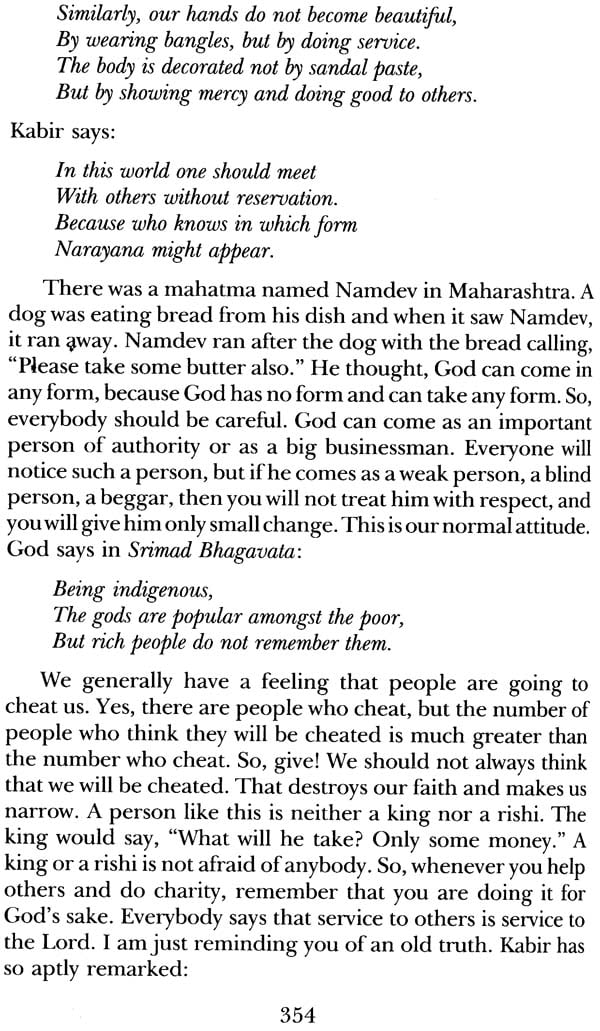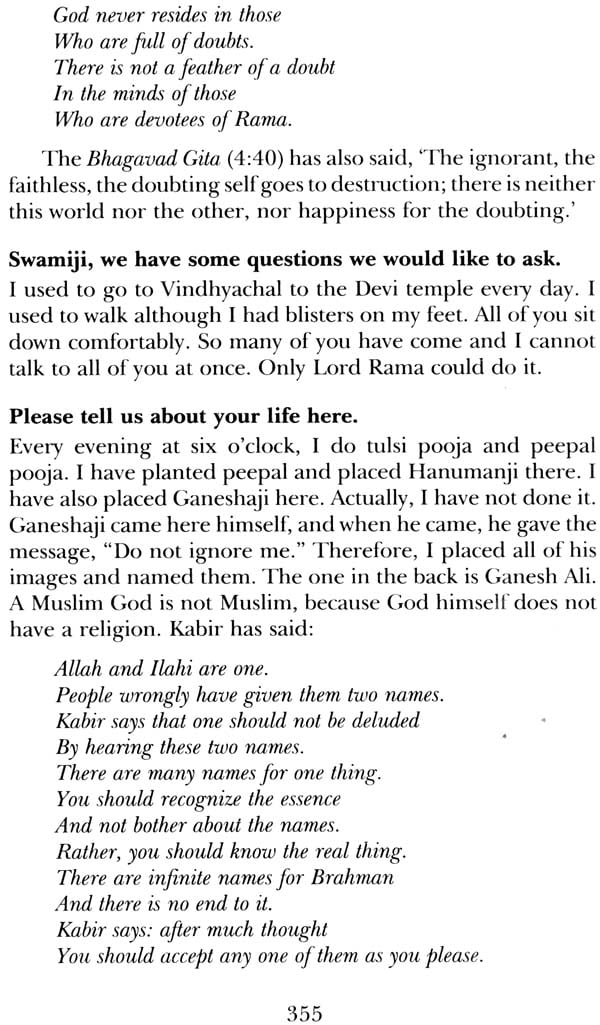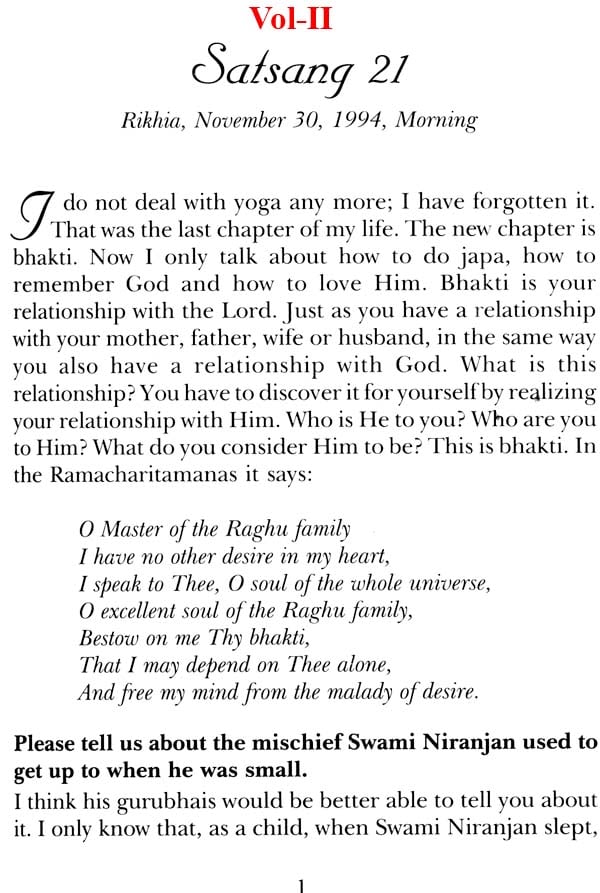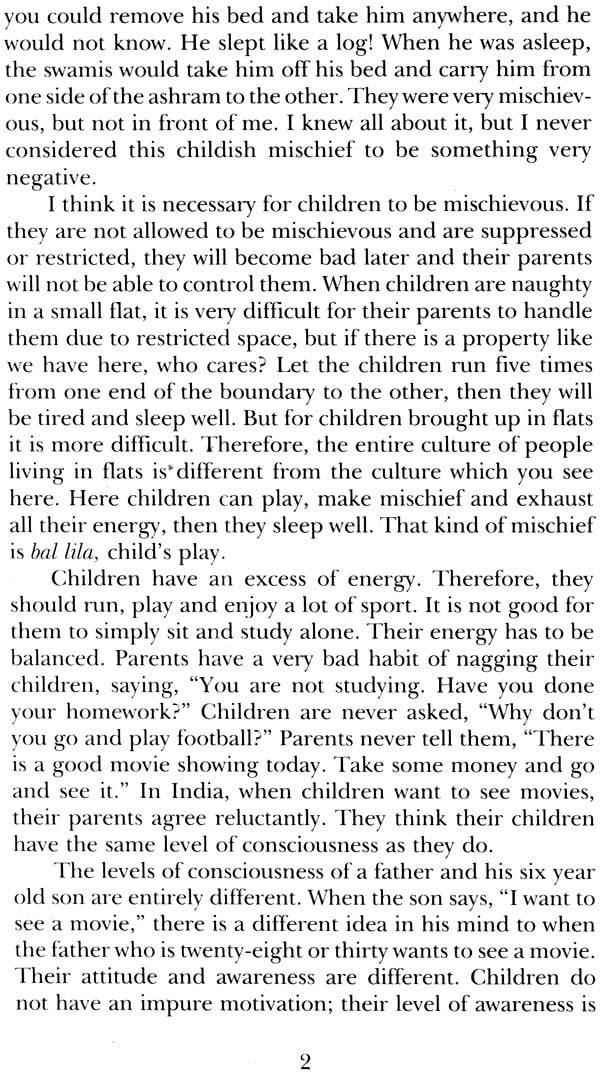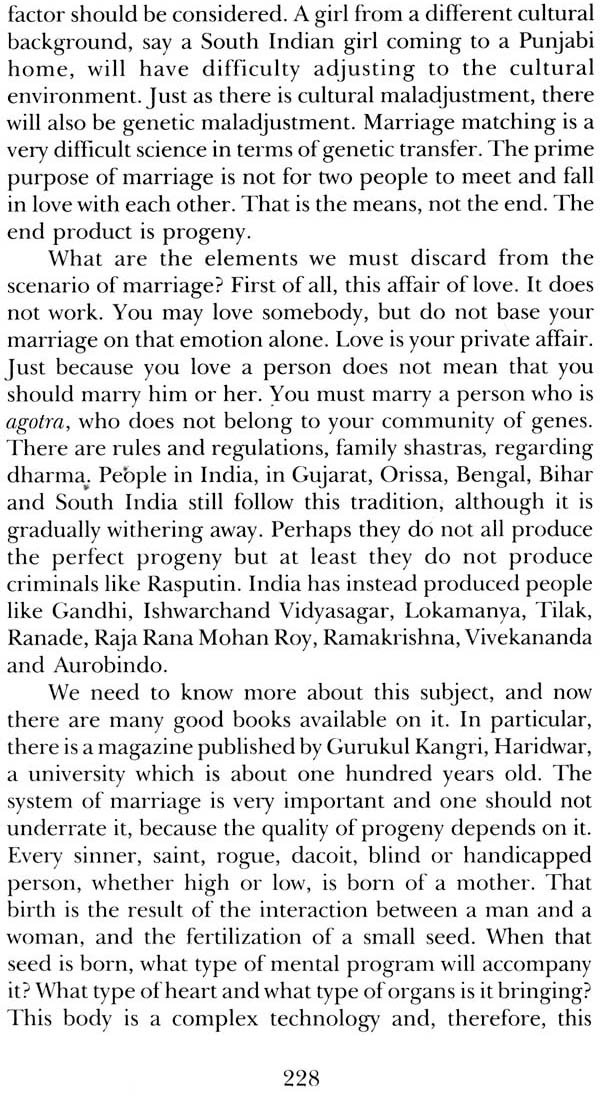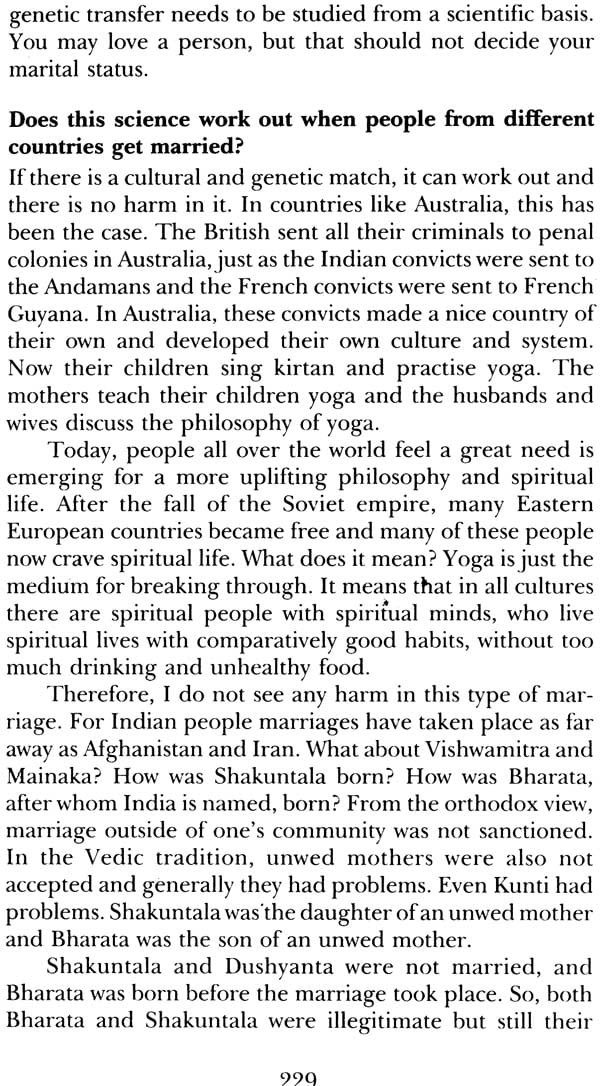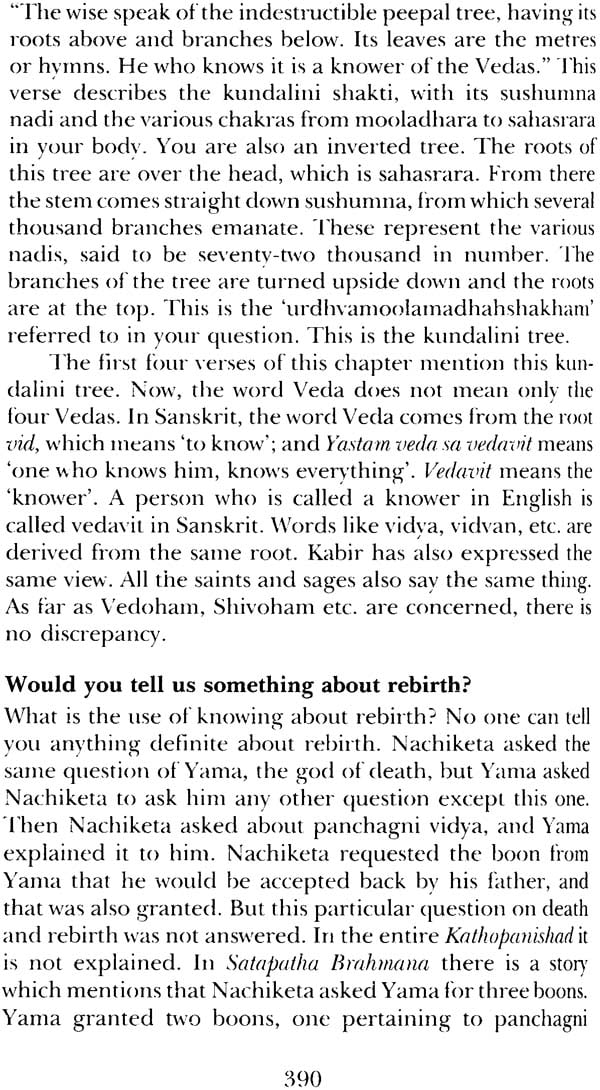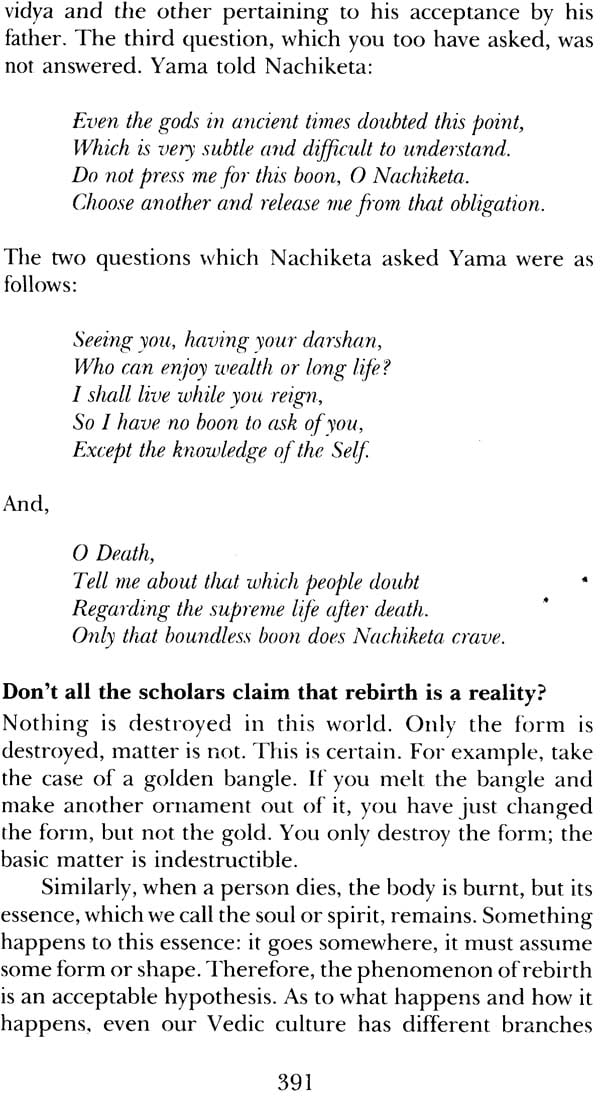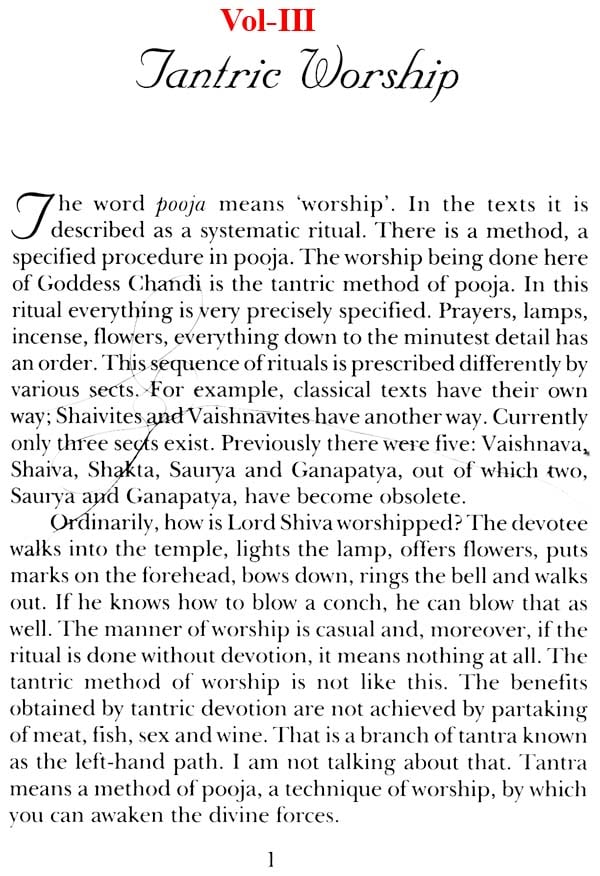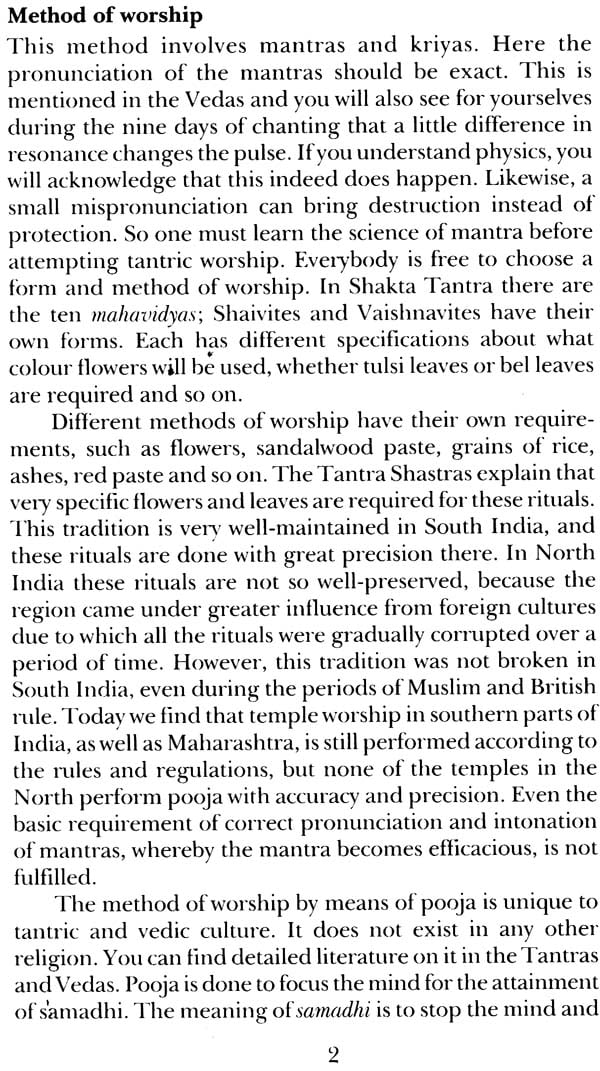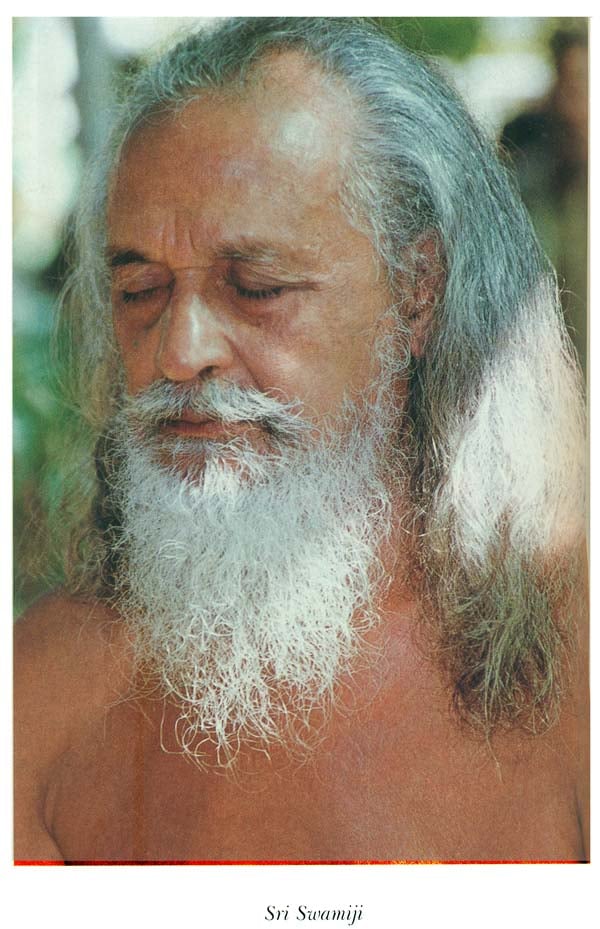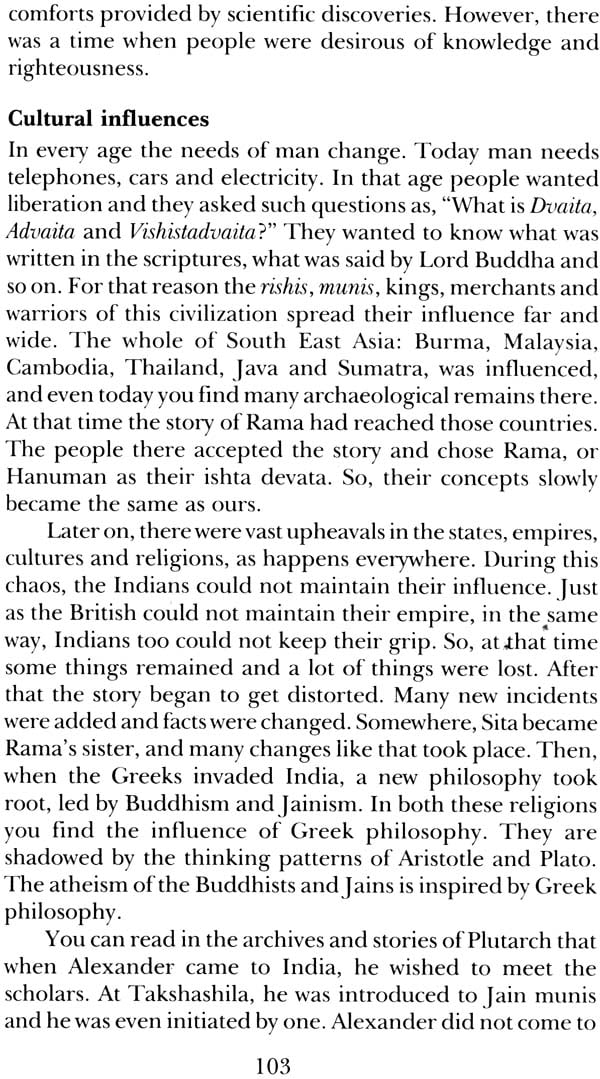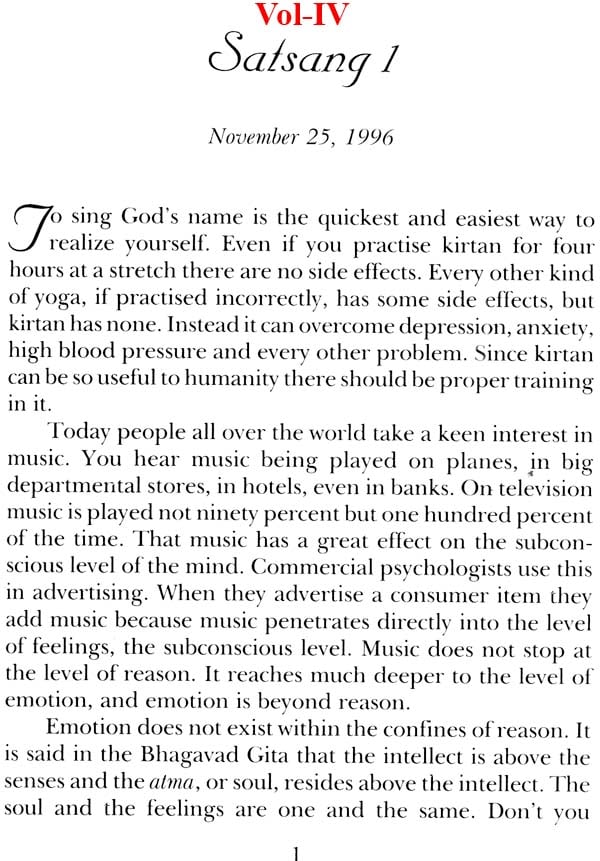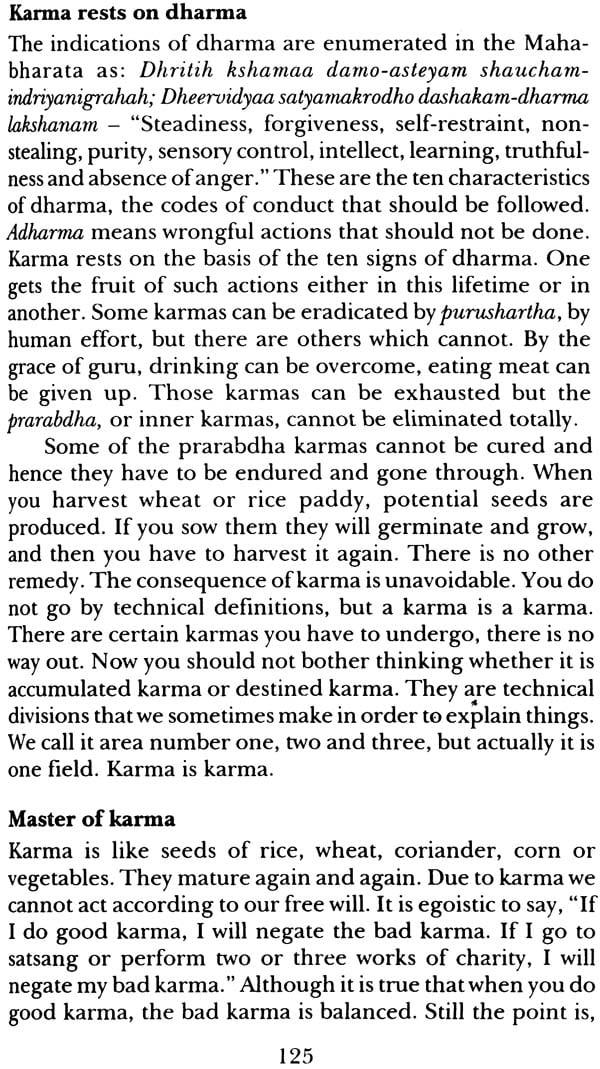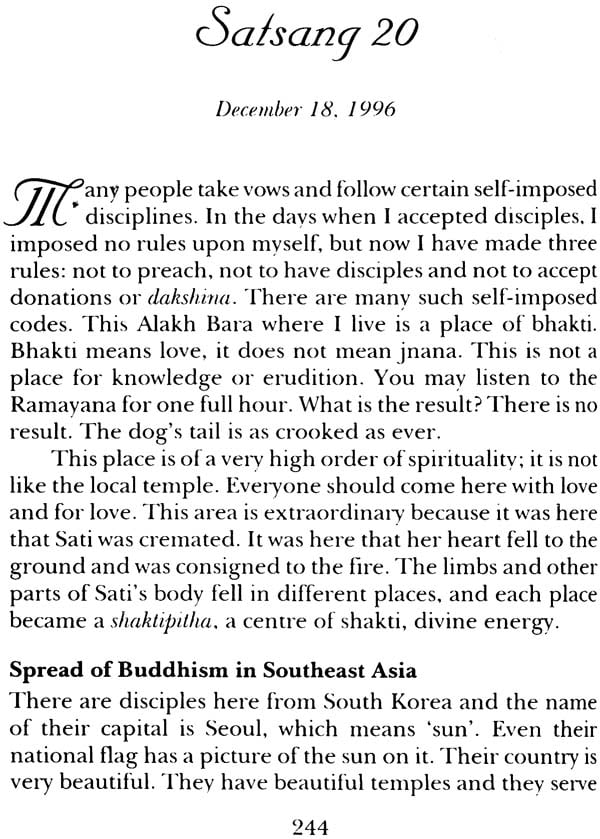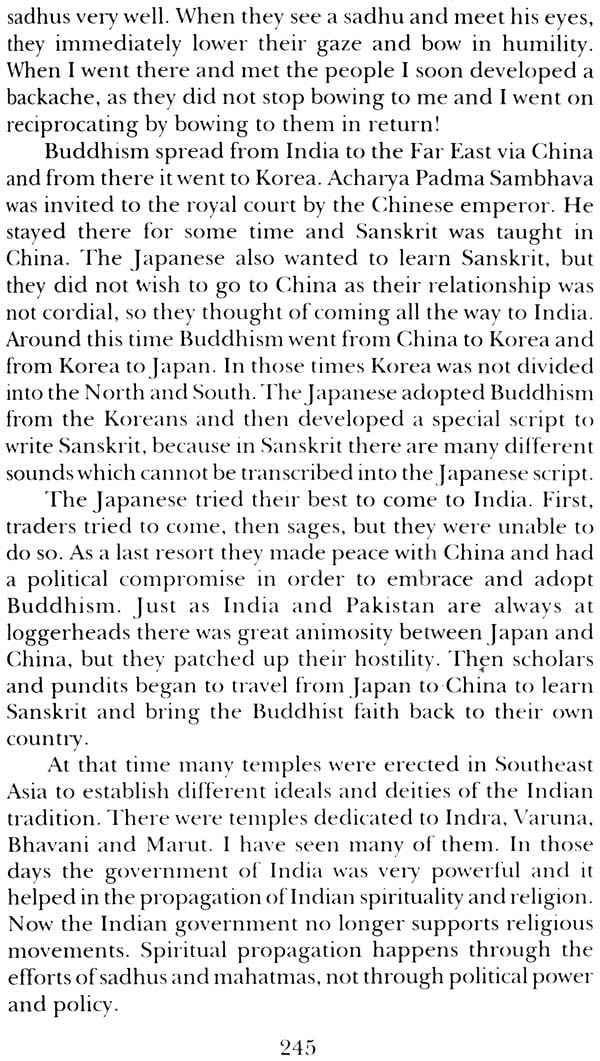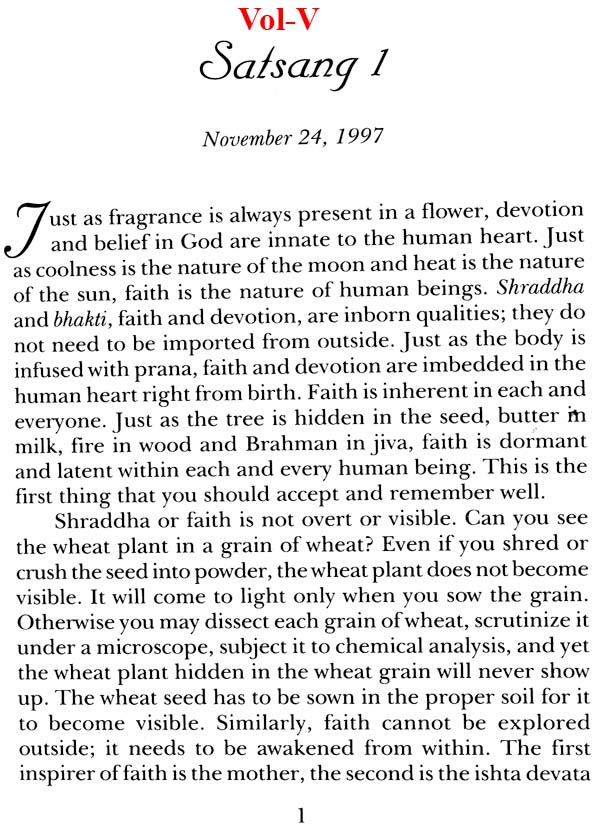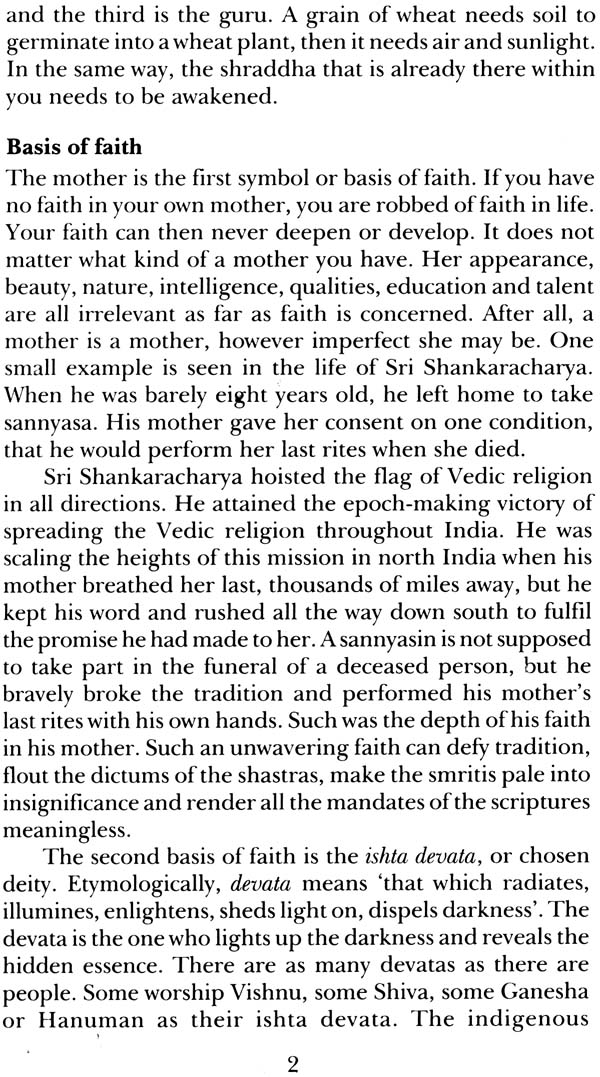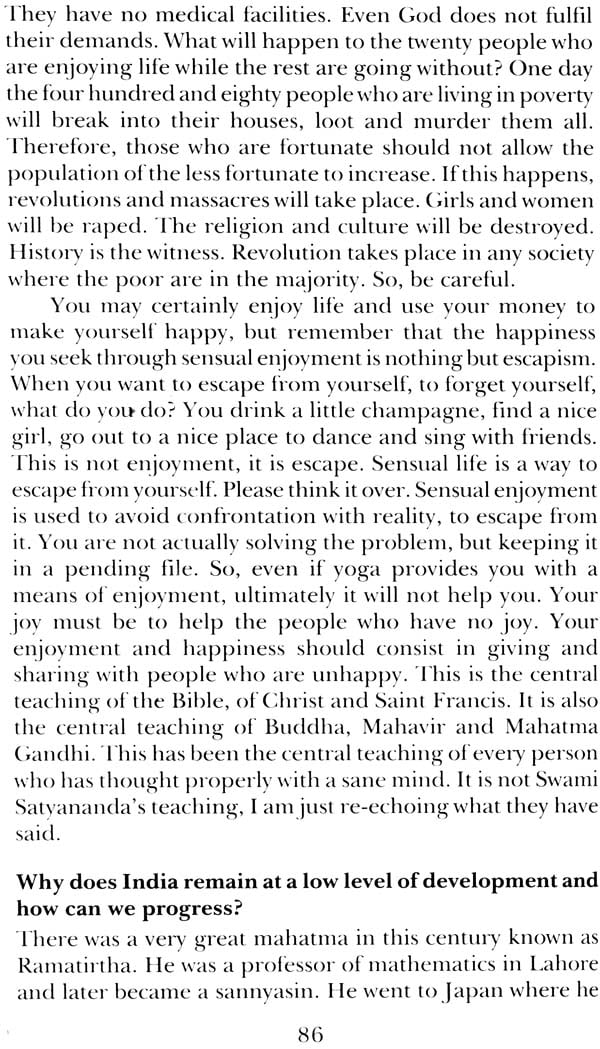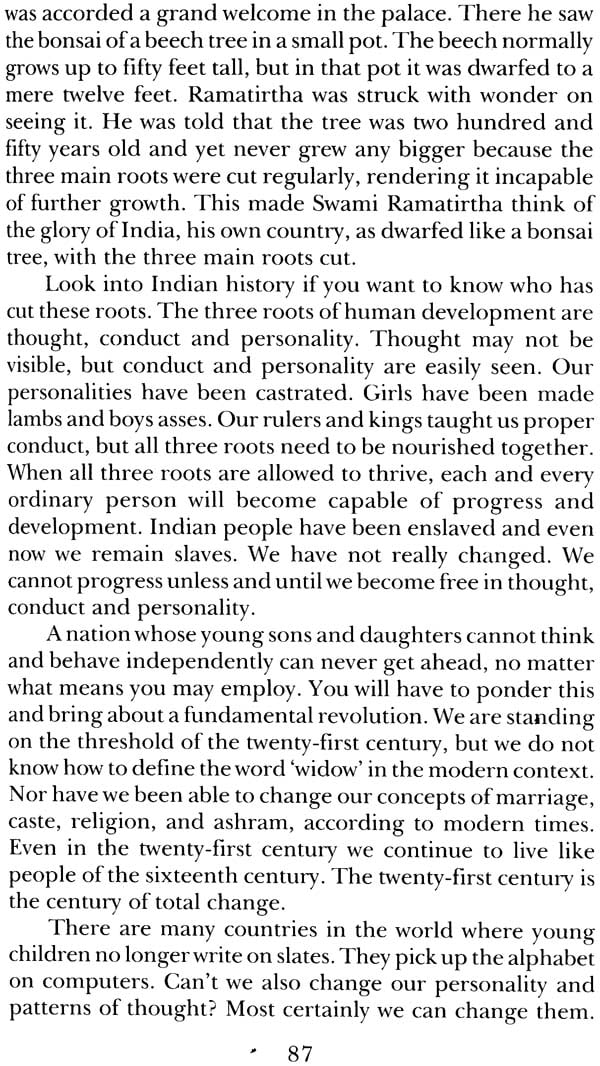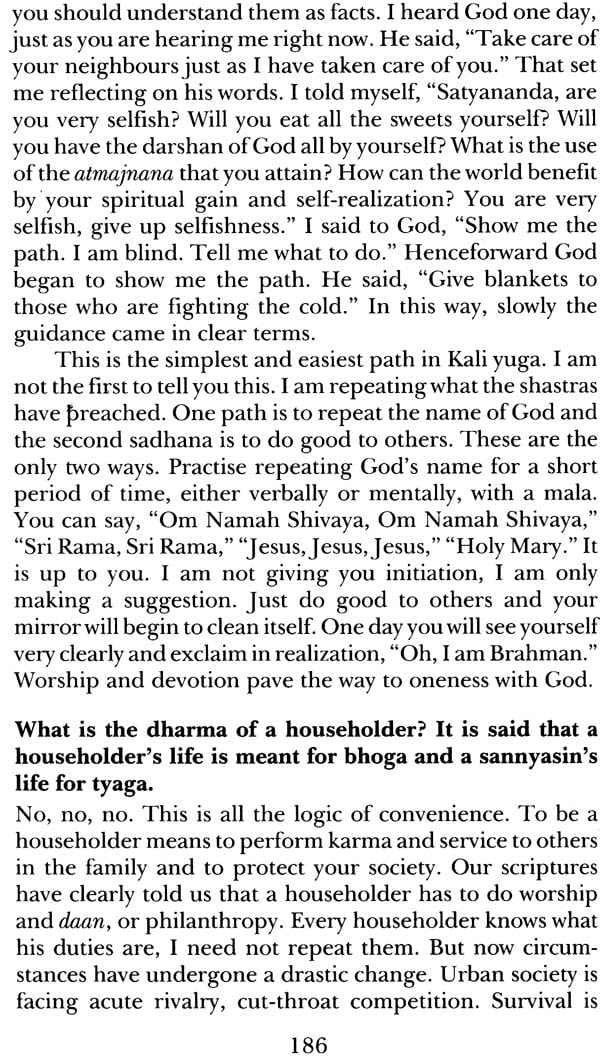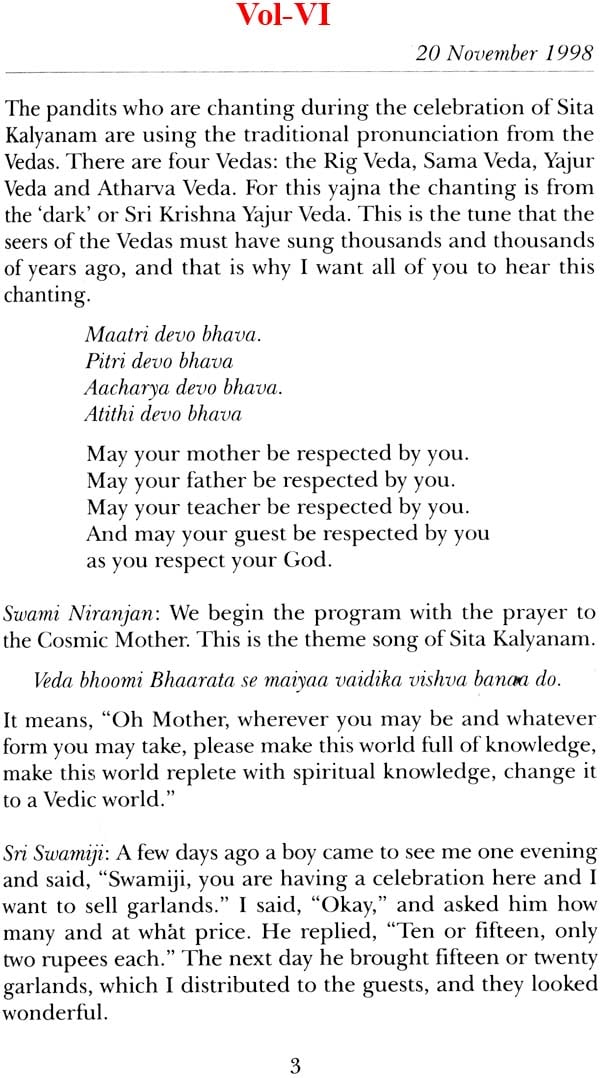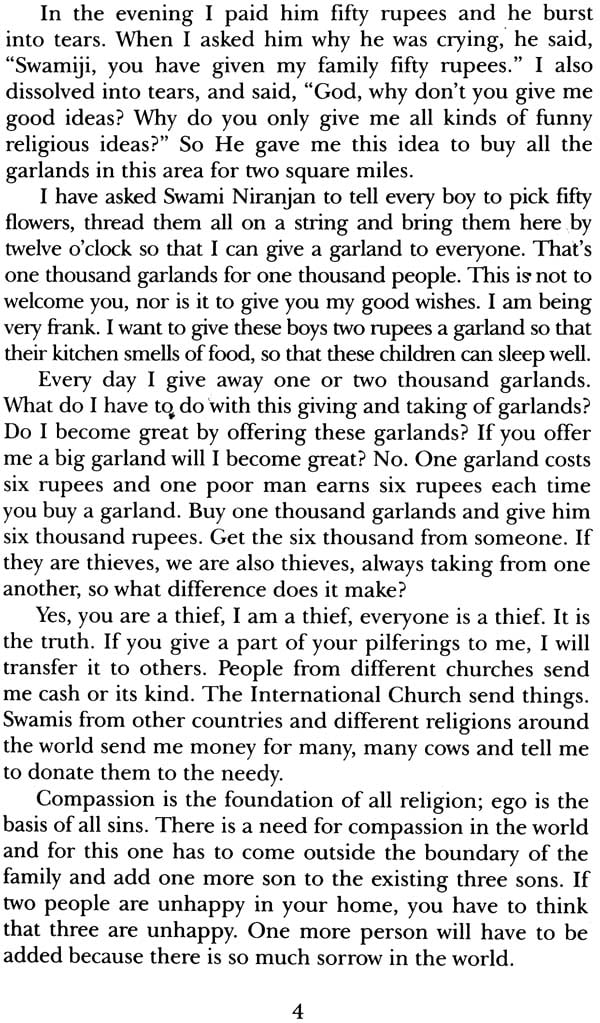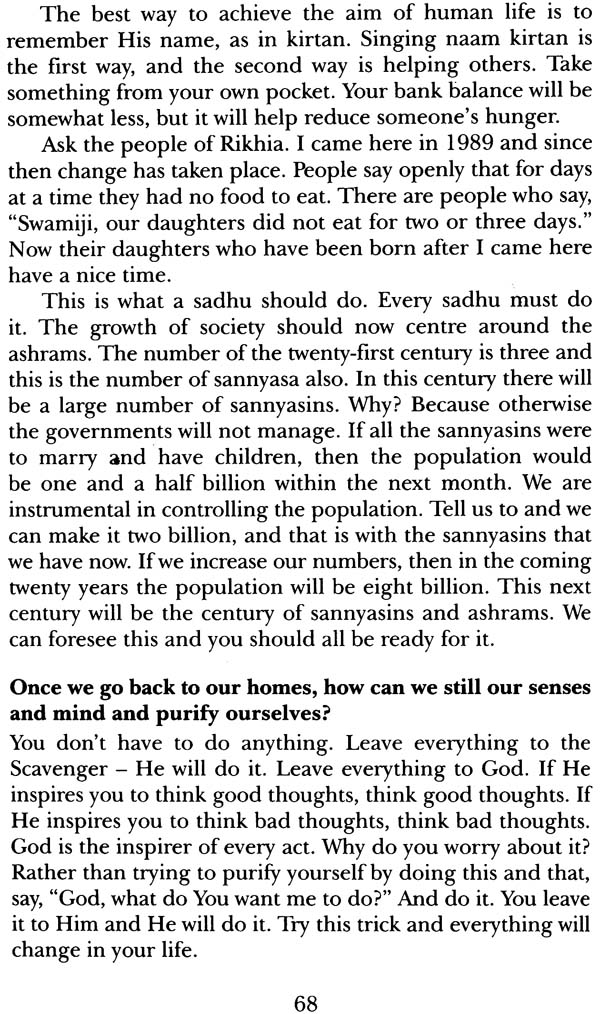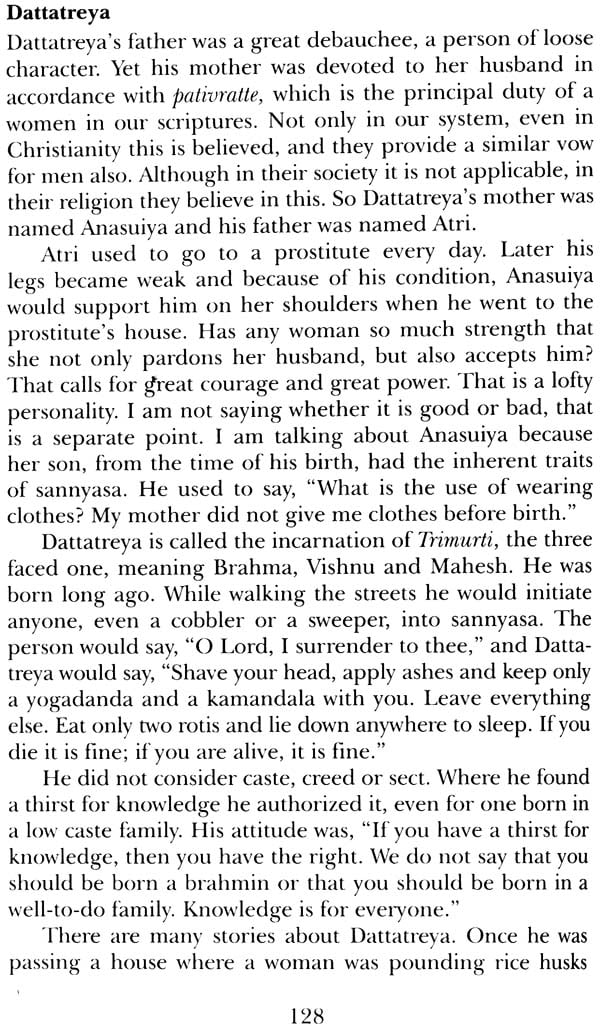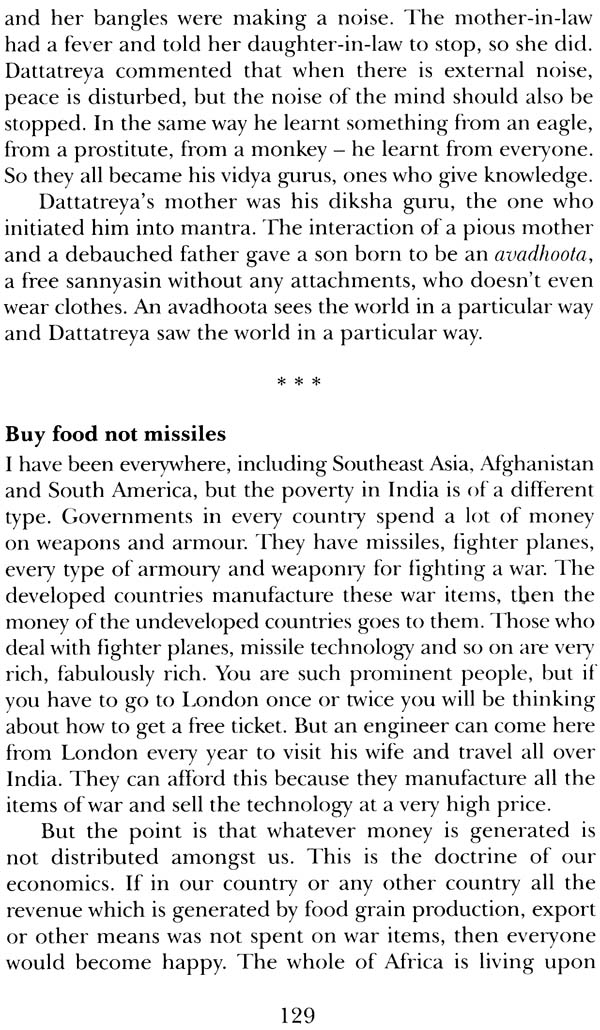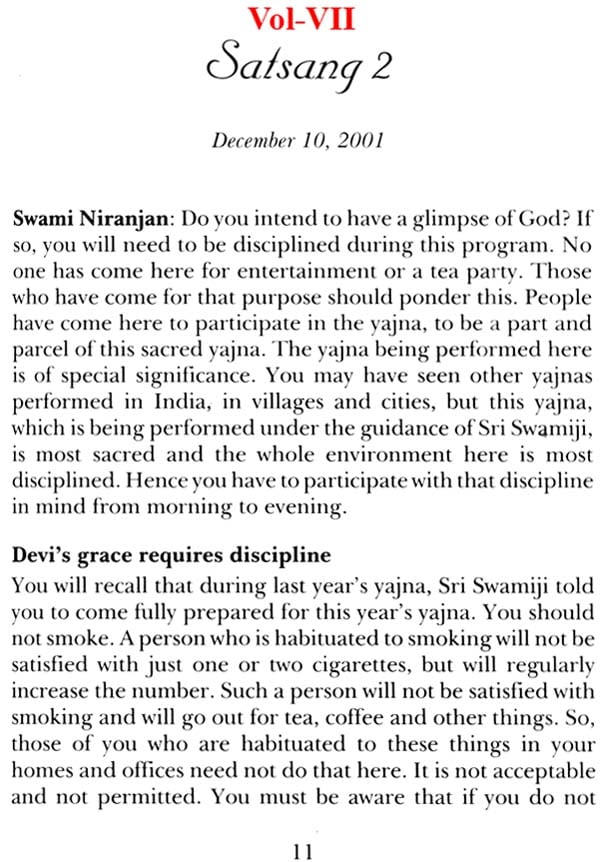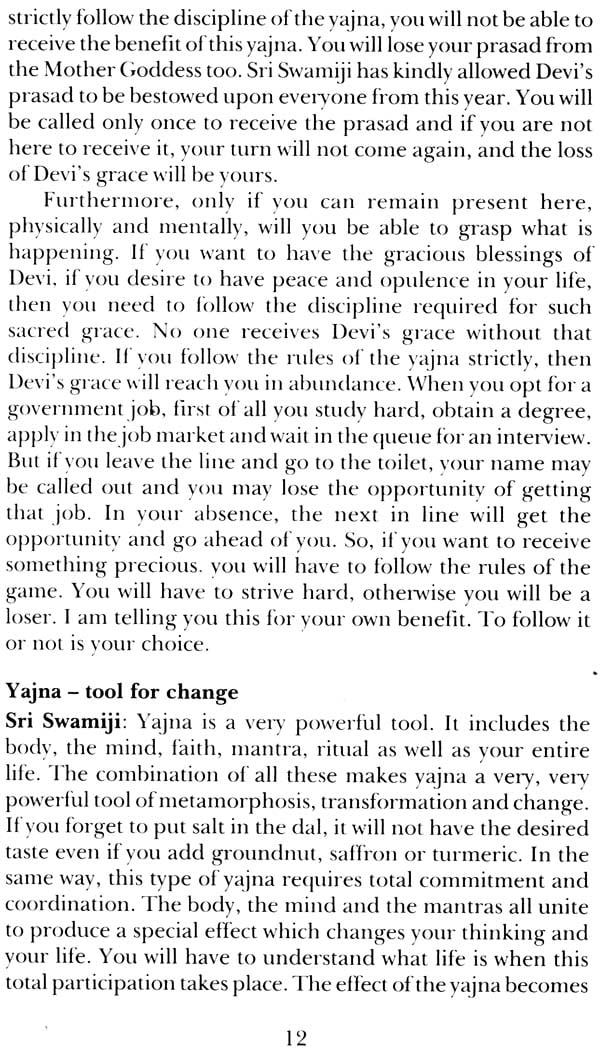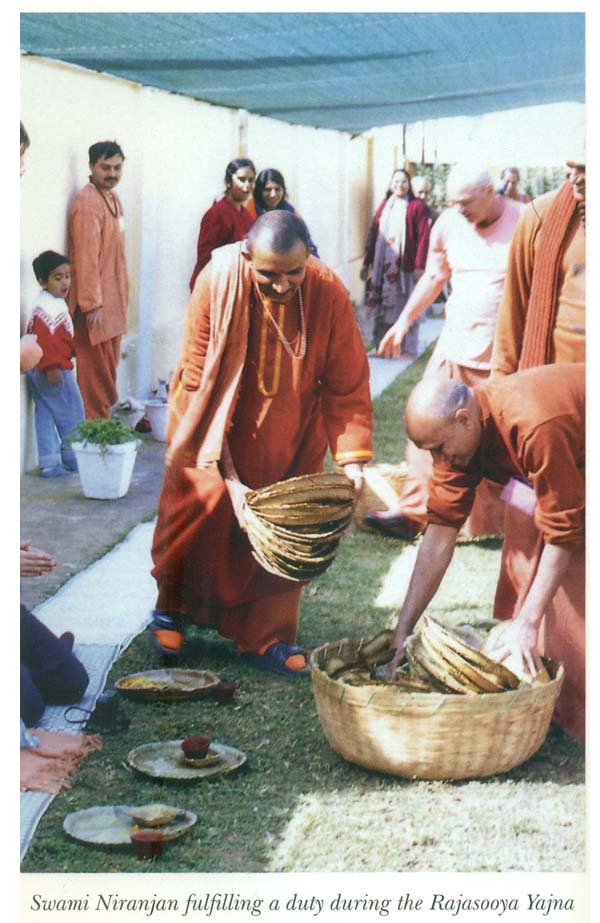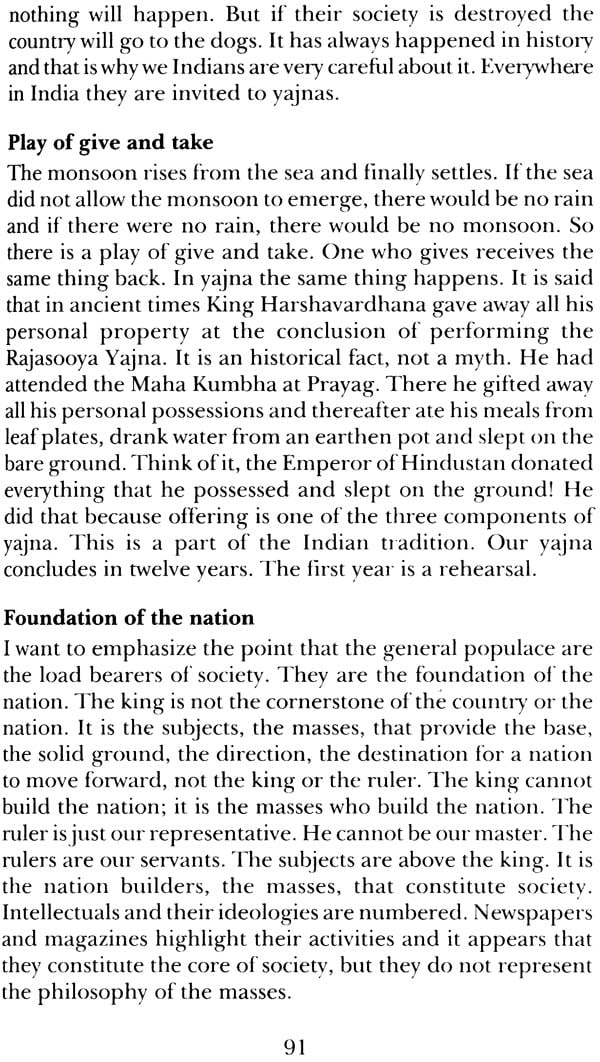
Bhakti Yoga Sagar - Ocean of the Yoga of Devotion (Set of 7 Volumes)
Book Specification
| Item Code: | NAO077 |
| Author: | Swami Satyananda Saraswat |
| Publisher: | Yoga Publications Trust |
| Language: | English |
| Edition: | 2011 |
| ISBN: | Vol-I: 9788186336748 Vol-II: 9788186336205 Vol-III: 9788186336441 Vol-IV: 9788186336656 Vol-V: 9788186336175 Vol-VI: 9788186336250 Vol-VII: 9788186336284 |
| Pages: | 2044 (21 Color Illustrations) |
| Cover: | Paperback |
| Other Details | 9.0 inch X 5.5 inch |
| Weight | 2.80 kg |
Book Description
After five years of intensive sadhana, Swami Satyananda Saraswati emerged from seclusion in November 1994. Thousands of spiritual seekers from all over the world travelled to Rikhia, India, to be in his presence and to hear him speak on bhakti. Shakti Yoga Sagar Volume I presents a selection of Swami Satyananda's talks and answers to tjuestions during that time. Topics include spiritual life, developing one's relationship with God, the science of bhakti, sannyasa, his mission, projects in the local villages and the direction of yoga in the 21 st century. These revelations from a spiritual master have the power to transform one's life.
Swami Satyananda was born at Almora, Uttar Pradesh, in Sivananda in rishikesh, where he lived as sannyasin for the next 12 years.
Swami Satyananda founded the International Yoga Fellowship in 1956 and the Bihar School of Yoga in 1963. Over the next 20 years he toured internationally and authored over 80 book.
In 1984 he founded Sivananda Math, a Charitable institution for aiding rural development, and the Yoga Research foundation.
In 1988 he adopted kshtra Sannyasa and settled in Rikhia, Jharkhand, where he now lives as a paramahamsa Sannayasin.
In order for one to attain success in yoga, as well as in life, personal attainment and prosperity are not enough. For success, just three ingredients are required: commitment, dedication and devotion to that which is beyond oneself. Unless we are able to develop these three qualities in our yoga and in our life, we can never find satisfaction or fulfilment. Real success is not measured by status, monetary gain or any personal achievement, but by how much one is able to offer others in theirtime of need, for their upliftment and for the removal of their distress.
Man is not an island or a separate unit unto himself. We are all part and parcel of this world, of this vast universe. We are in the universe, and the universe is in us. No one is in any way different from another. All are comprised of the same consciousness and energy, the same five elements. All breathe the same air, drink the same water, eat the same food, walk the same earth. All feel the same emotions and think the same thoughts. So, what is it that makes us feel different from each other? Our illusion about self, our sense of individuality, of self-importance, of egocentricity, which blocks our vision of totality, of oneness with humanity and with the entire creation. When will we be free? Freedom is not a commodity which can be purchased politically, socially or professionally. Freedom is an understanding of oneself in relation to others, the part in relation to the whole. We will never be free until we learn to share with others. There is always someone with less than us, no matter how little we have. There are thousands of ways to share our knowledge, abilities, facilities, experience, faith, belief, money, property, food, clothes, books, ideas.
It is not by accumulating and enriching ourselves that we become free. We become free by giving what we have to others. The different ways and forms of our sharing are the measure of our freedom, of our capacity to realize God. By God, I do not mean that Holy Father who lives up somewhere in heaven, but that divinity which resides in us and in all beings, sentient and insentient, in equal measure.
It is of no use to build up anything for ourselves. All these accumulations become our bondage, our barrier. They keep us fenced off from the higher reality, the vision of totality. The more we give, the greater we become, because we learn to see ourselves in others. Their suffering becomes our suffering and their joy our joy.
A life of selfish acquisition and material satisfaction is not worth living or dying for. At the end of it, what will we have that is still ours? Nothing. No money, no possessions, no property, no house, no car, no job, no relation, no friend will ever pass out of this life with us. The only thing that will go with us on that last day will be our karmas, our deeds, whether positive or negative, selfish or unselfish, and nothing else. That is why in this life it is very, important to always be on the lookout for opportunities to give, to serve and to contribute something for the welfare and betterment of another. This is the way to attain happiness, fulfillment and transcendence in this life and in the life to come. With every positive deed, we remove the shackles of ten years of negative deeds. We become brighter, younger, healthier and more vital.
What is it that makes us dull, old, sick and oppressed? The cause is not external; it is our internal limitations which bind us to a narrow, selfish view of life. That is the cause of all our suffering. In order to remove our suffering we must remove our limitations. We must live to help and serve others and not ourselves. We must reach beyond our immediate family and our personal needs, and develop a broader identity that encompasses the entire humanity, the entire creation, the entire cosmos. This is freedom; not any political, social or religious ideology.
Nowadays, people in the West have forgotten the spirit in which yoga first came to them from this land. They have made their own yoga federations and associations, and erected high fences around them. Each says, "This is our yoga. No other yoga is permitted here. Learn our way, teach our way, or get out." So we find British yoga, French yoga, Greek yoga, German yoga, Swedish yoga, Italian yoga, Japanese yoga, USA yoga, but these are not the yogas that I teach or ever taught.
I have taught only one yoga, that which leads to freedom. All others are paths of bondage. Please do not think that I am speaking against any yoga teacher or institution, but I feel that the present concept and direction of yoga must change. Yoga must be unified, freed of separate ideals, power struggles and narrow concepts of spiritual attainment.
Attitudes must change, barriers must come down, so that a new yoga can emerge. This will be the yoga of unity, of giving, sharing and uplifting as one team. As organs and parts of one body, we must work together in one connected and concerted effort to serve humanity, to share our knowledge, our gifts, our capacities, our labour, for the common good, for a better world.
k When we are able to see the disease, disharmony and distress of others as our own, and begin to alleviate and remove it by our united effort, then our yoga will need only one banner. Call it freedom, call it mukti, call it bliss. If we are involved in any yoga for our personal development, knowledge and evolution, that yoga is not going to help us. Finally we will have to leave it and search for another path. The ways of the world are many, but the way to God, to spirit, to divinity, is one. Dedication to the upliftment of others, seeing others in oneself and one self in others; this is the ultimate yoga. There is no other way to change our limited, egocentric vision to a cosmic vision. This is the path and this is the yoga of the next century; call it 'freedom yoga.
There is no need to waste time in practising other yogas. Life does not have enough days, hours and minutes to perform all the good deeds that need to be done in order to balance the bad deeds that were done before. In this birth, we have the opportunity to serve the poor and downtrodden by offering food, clothes, money, medicine, books, toys, tools, building materials, bicycles, cows, bullocks, and other things which can help to remove distress from the lives of individuals, families and communities.
This is my path, and this is the yoga that I wish to propogate in the coming century for the benefit of all mankind and the highest attainment of yoga. There is no other nirvana, no other enlightenment. This is the way to freedom.
It is not my intention to insult or offend anyone's view, concept or practice of yoga. However, we must bear in mind that the yogas expounded in the twentieth century were suited to the needs and evolution of humanity for that period. Therefore," the form of yoga was limited to self-discipline, self-introspection and self-improvement.
Now, yoga is taking another step forward. It is expanding beyond the personal, selfish and narrow confines of individual practice, teachings and ideals, to encompass a broad spectrum of devotion, dedication and integral participation in human emancipation.
This is not my order. It has been decided by forces which are beyond me. There will be no other way to evolve through yoga. All will eventually have to pull down their separate fences and signboards and begin to work together in one united, consecutive effort to uplift and free humanity from all forms of deprivation and degradation.
The misery of others is our misery. To free another of their misery is our freedom, our happiness and our fulfillment. Not to speak of freeing whole families, communities, states, nations and worlds. Freedom is infinite for those who walk in the light of this yoga, who take up the path of giving and sharing, and who devote their time and their money to the upliftment of others.
| Vol-I | |
| Foreword | xi |
| Satsang One | 1 |
| Two | 24 |
| Three | 38 |
| Four | 52 |
| Five | 69 |
| Six | 90 |
| Seven | 113 |
| Eight | 139 |
| Nine | 156 |
| Ten | 172 |
| Eleven | 195 |
| Twelve | 208 |
| Thirteen | 217 |
| Fourteen | 211 |
| Fifteen | 283 |
| Sixteen | 297 |
| Seventeen | 313 |
| Eighteen | 321 |
| Nineteen | 336 |
| Twenty | 358 |
| Glossary | 375 |
| Index | 398 |
Bhakti Yoga Sagar Volume 2 includes further inspiring talks and answers to questions given by Swami Satyananda Saraswati in December 1994 when he emerged from seclusion after five years of intensive yogic sadhana. Sub- jects include his sannyasa life and mission, experiences in Rikhia, aspects of bhakti, discovering one's relationship with God, bhakti as the science of the 21 st century, the work of Sivananda Math in the local villages of Rikhia, and many other topics of interest to all spiritual seekers.
In 1994, during the auspicious month of Marga Sheersha J from 18th November to 17th December, darshan was given by Sri Swamiji at the Sri Panchdashnam Paramahamsa Alakh Bara in Rikhia, Deoghar District. During this month the ocean of bhakti yoga swelled over the crowds that had gathered for this occasion from all corners of India and the world. Multitudes of devotees, disciples and admirers poured in like a river making its way towards the sea, during this period when Sri Swamiji had consented to give darshan for the first time in over five years.
During this darshan, the treasure of seven decades of spiritual experience began to flow from Sri Swamiji like a stream of compassion, and it became difficult to bind this flow in words. However, the first collection of satsangs from the 1994 darshan was published on the occasion of the Sat Chandi Maha Yajna in November 1995 under the title Bhakti Yoga Sagar - Volume One.
Since discovering that his relationship with God is one of master and servant, Sri Swamiji has faithfully followed the orders of his master with complete devotion and dedication. Obedience and service to the Lord in the form of the master and servant relationship have become his way of life, and in 1992, he received the following mandate from the Lord.
| Foreword | ix |
| Satsang Twenty-one | 1 |
| Twenty-two | 17 |
| Twenty-three | 41 |
| Twenty-four | 79 |
| Twenty-five | 99 |
| Twenty-six | 135 |
| Twenty-seven | 152 |
| Twenty-eight | 167 |
| Twenty-nine | 196 |
| Thirty | 234 |
| Thirty-one | 245 |
| Thirty-two | 265 |
| Thirty-three | 286 |
| Thirty-four | 324 |
| Thirty-five | 350 |
| Thirty-six | 368 |
| Thirty-seven | 377 |
| Thirty-eight | 410 |
| Glossary | 427 |
| Index | 447 |
Bhakti Yoga Sagar Volume 3 consists of satsangs given by Swami Satyananda Saraswati at the first Sat Chandi Mahayajna conducted at Rikhiapeeth in November 1995. During the nine days of this unique event, Sri Swamiji enlightened one and all on the significance of worshipping the Divine Mother, the purpose of yajna, kanya kumari pooja, the role of women in modern society, practical measures to uplift the underprivileged villagers, shaktipat and the tantric initiation of Swami Niranjanananda Saraswati. This book is a powerful message to open the heart.
The Sat Chandi Maha Yajna was a totally new exposure for most of the yoga aspirants, devotees, disciples and even the sannyasins of Bihar School of Yoga. Until now we have been' involved with the yoga practices. However, the yajna as a tantric ceremony, the meaning of which very few people know about. The yajna also represented another step in the life of an individual to understand or to communicate with the higher nature. This yajna was held in Rikhia because Swami Satyananda wished that the hitherto unknown aspects of tantra should be slowly brought out. At present the science of tantra is misunderstood by many people who regard it as a means of magic or manipulation, rather than as an evolutionary science.
The science of tantra is based on the three aspects of mantra, yantra and mandala. When sadhana is performed utilizing these three tools, the higher mental faculties are awakened and the mind becomes powerful. The actual aim of tantric sadhana is not to utilize these powers for personal motives or material gain, but to propitiate and harmonize the energies which at present are unharnessed and uncontrolled in the individual as well as in the external nature and in the cosmos. Throughout the ten days of the yajna, different mantras were chanted for the propitiation of Devi or Chandi by a specially selected group of Brahmin pandits who had come from such distant places as Madras, Varanasi and Kanchipuram, and whose pronunciation, swara and metre were a special experience to hear.
Just as the Bhagavad Gita has 700 slokas in which the wisdom of yoga is transmitted by Sri Krishna to his cousin and disciple Arjuna, similarly, Durga Saptashati, the text which was chanted during each day of the yajna, contains 700 slokas about the Cosmic Mother. Durga Saptashati is a very important tantric text which is traditionally chanted twice every year during the period of Navaratri, the nine days dedicated to the worship of the Cosmic Mother. It is a dialogue between Sage Markandeya, one of the greatest thinkers of the ancient spiritual tradition, and the warrior King Sural. Markandeya tells Surat about the different aspects of the Mother Goddess, her powers, omnipresence and creation. The beeja, or seed, mantras contained within these slokas awaken the energies within the individual as well as the environment. The chanting of each verse is chorused by a combination of three beeja mantras: Aim Hreem Kleem. Aim is the beeja mantra of Saraswati, Hreem of Lakshmi, and Kleem of Durga or Kali.
Mandalas and yantras were made on the tables inside the yajna mandap, and on top of each mandala and yantra was placed a symbolic image of the deity to be invoked. Deities were invoked in each pillar, corner, mandala and yantra. The pots on each side of the gate inside the yajna mandap were the ten kshetrapals, or protectors, and inside them was water brought from various rivers. The water that was used inside the mandap was brought from Gangotri, the origin of the Ganga, high in the Himalayas. On the last day of the yajna, after the havan, all these deities were asked to leave, because when you invoke a higher power, you also have to release it. This was the concept of bringing down the cosmic forces to be with us, and then releasing them after the work was over.
The success of a yajna such as this is not measured by the expenditure incurred or the number of people who came to participate in it. The success depends on each individual, on how much each one has offered of body, mind and spirit. Industrialists can spend millions organizing a beautiful yajna, but if the feeling of devotion is not present, the yajna will not be effective. The special aspect of this yajna was the shraddha, the faith, and bhakti, the devotion, of the devotees from all castes, creeds and religions who gathered in Rikhia from all parts of the world. Although they could not understand any of the rituals and chanting, they sat with eyes closed from morning until evening and tuned into the divine vibrations present in the environment.
The yajna was a unique and special event in many ways, the main one being that a siddha saint was present as a guiding force during every moment. The teaching that he gave to all the participants through his personal example was to see the divinity in everyone and everything around you. Do not think of God as something far away. Do not be afraid of God, rather, try to understand the divine nature, the divine force which is inherent in each and everyone. The absence of that force is death. God is present in each and every aspect of creation. God is not formless. Maybe one of the attributes of God is formlessness, but definitely God has form. Each individual is a symbol of that form. The recognition of that divine nature in each and everyone is the sadhana which was given by Sri Swamiji during the yajna. It is not only a recognition, but also a feeling of oneness with other beings, identifying with their suffering and also with their happiness. Let everyone take a sankalpa to preserve this gift from Paramahamsaji for times to come. Swami Niranjanananda Saraswati
| Introduction | i |
| Tantric Worship | 1 |
| Instructions for the Yajna | 9 |
| Prasad | 17 |
| Role of Women in Modern Society | 20 |
| Upanayan Samskara | 31 |
| Mother India | 35 |
| Cultural Transition | 45 |
| Religion, Politics and Sannyasa Dharma | 51 |
| Emancipation of the Villages | 57 |
| Why Ganesha Drank Milk | 64 |
| Advice to the Young | 75 |
| Commitment to God | 84 |
| Manifest Form of God | 88 |
| Jewel of Faith | 92 |
| Changing Social Codes | 95 |
| The Story of Rama | 100 |
| God's Name | 112 |
| Three Disciplines | 120 |
| Spirit of Compassion | 125 |
| Pilgrimage Sites | 129 |
| Historical Fact and Tradition | 134 |
| Dance of Shiva | 137 |
| Christ Kutir | 139 |
| Disease Neurosis | 143 |
| Avadhoota Tradition | 147 |
| Living Experience | 150 |
| Gurubhais and Ashram Days | 153 |
| Diversity is Truth | 159 |
| Sanskrit Language | 165 |
| Sacrifice | 167 |
| Conch and Shaligram | 170 |
| Tantric Initiation | 173 |
| Sankalpa of Second Generation | 181 |
| Succession | 183 |
| Kumari Poojan | 187 |
| Initiation Ceremony | 191 |
| Impressions | 195 |
| Glossary | 216 |
| Index | 230 |
Bhakti Yoga Sagar Volume-4, consists of satsangs by Sri Swami Satyananda Sraswati in Rikhia, India during the Ram Naam Aradhana, held during the month of Marga shirsha (Novermber-December) 1996. During this festival, devoted to the worship of Sri Rama, Sri Swamiji expounded on the benefits of singing God’s name as the easiest sadhana to purity the heart and mind. He also said that compassion is the highest virtue and can be developed b contributing selflessly to the welfare of others. Soritual sekers should look for God among the poor and needy, as to see God in human form is the greatest sadhana in life.
| Index | 230 |
| Satsang One | 1 |
| Two | 12 |
| Three | 19 |
| Four | 33 |
| Five | 41 |
| Six | 51 |
| Seven | 75 |
| Eight | 87 |
| Nine | 93 |
| Ten | 106 |
| Eleven | 117 |
| Twelve | 136 |
| Thirteen | 147 |
| Fourteen | 165 |
| Fifteen | 17 8 |
| Sixteen | 192 |
| Seventeen | 211 |
| Eighteen | 223 |
| Nineteen | 229 |
| Twenty | 244 |
| Twenty | 258 |
| Twenty | 281 |
| Twenty | 291 |
| Twenty | 305 |
| Twenty | 314 |
| Twenty | 31 7 |
Bhakti Yoga Sagar Volume 5 consists of sastrangs vigven by Swami Satyananda Saraswati in 1997 during the sita Kalyanam festival in Rikhia. India during this festiva, organized for the welfare of the newly wed bribes from the local villages, Sri Swamiji answered questions on such topics as how to develop love and compassion for others through giving and serving, how to manage the mind and emotions through devotion to God, the guru-disciple relationship, his work to to uplift the needy villagers living in his neighborhood, the position of women in society, marriage, family life and education.
With his incomparable wisdom and humour, Sri Swamiji explain how and why people must change and adapt in order to meet the needs of the 21st century.
| Twenty | 317 |
| Satsang One | 1 |
| Two | 10 |
| Three | 20 |
| Four | 30 |
| Five | 45 |
| Six | 58 |
| Seven | 71 |
| Eight | 89 |
| Nine | 104 |
| Ten | 116 |
| Eleven | 127 |
| Twelve | 142 |
| Thirteen | 155 |
| Fourteen | 167 |
| Fifteen | 179 |
| Sixteen | 189 |
| Seventeen | 200 |
| Eighteen | 208 |
| Glossary | 213 |
| Index | 220 |
Bhakti Yoga Sagar Volume Six consists of Satsangs given by Swami Satyananda Saraswati during the Sita kalyanam festivals in Rikhia, India, from 1998 to 2000. Sri Swamiji’s love and respect for the divine Mother and all her children is transparently clear. His practical help to all needing spiritual guidance and particularly for the needy villagers, women, and those willing to dedicate their lives to God is heart warming. Through the Vedic and Transric traditions of yajna, mantra repetition seva and sharing wealth, he gives effective practices for the spiritual, social and ecological needs of today.
With his characteristic blend of wisdom, humour, compassion and pragmatism, Swami Satyananda’s dynamic message of hope continues to inspire people around the world.
| Sita Kalyanam 1998 | |
| 20 November | 3 |
| 22 November | 5 |
| 23 November | 13 |
| 24 November | 15 |
| Sita Kalyanam 1999 | |
| 5 December | 19 |
| 6 December | 20 |
| 7 December | 22 |
| 8 December | 22 |
| 9 December | 30 |
| 10 December | 35 |
| 11 December | 37 |
| 12 December | 38 |
| 13 December | 39 |
| Sita Kalyanam 2000 | |
| 22 November | 45 |
| 23 November | 57 |
| 24 November | 69 |
| 26 November | 81 |
| 27 November | 91 |
| 28 November | 100 |
| 29 November | 105 |
| 29 November | 121 |
| 1 December | 141 |
| Glossary | 148 |
| Index | 156 |
Bhakti Yoga Sagar Volume 7 is a collection of satsangs given by Swami Satyananda Saraswati in Rikhia, India, during the Sita Kalyanam festival and Sat Chandi Mahayajna in December 2001 . During this time Sri Swamiji inaugurated the Rajasooya Yajna. The speciality of the Rajasooya Yajna is the art of giving and receiving and this is exemplified in Sri Swamiji's emphasis on providing practical assistance for those in need, as well as encouraging an attitude of giving and sharing in life. With an all-encompassing vision that is both pragmatic and compassionate, Sri Swamiji addresses the spiritual and social needs of the 21 st century and resents a path for the peace and wellbeing of all.
The Sat Chandi Mahayajna at Rikhia in 2001 attracted thousands of people from all parts of the world. It meant so many things to so many people. The magnanimity of the event was awesome. The multitudes of people, the diversity of events, the profundity of the sacred rituals, the participation of people from so many different nationalities, religions, and diverse classes, colours and creeds, the enrapturing melodies and mantras all blended perfectly with each other.
But above an it was the uninterrupted presence f Swami Satyananda that added the final touch to the event by giving it a spiritual vibrancy that was unmatched. One can certainly say that apart from attracting thousands of people, the yajna also attracted the divine forces to grace us with their luminous presence. The smoothness, ease and splendour with which it was carried out only points a finger in that direction. No human effort could have made it so attractive.
The most significant part of the yajna was the sankalpa of Rajasooya Yajna made by Sri Swamiji. After twelve years of rigorous and arduous panchagni and allied sadhanas, which he commenced in 1990, Sri Swamiji inaugurated the Rajasooya Yajna and said that it will continue for the next twelve years. The only difference is that he did panchagni in total isolation whereas the Rajasooya Yajna will be done in the presence of everyone, with their participation and involvement. The Rajasooya is a yajna which can be held only by a chakravarti, or one who is recognized as a conqueror. Ordinarily when we speak of conquest we attribute it to territories, kingdoms and countries. But this is not necessarily so. One who conquers the world through an idea, a thought or a philosophy can also be proclaimed a chakravarti.
A conqueror of hearts is a chakravarti too. Krishna, although he was a conqueror in every sense of the word, did not perform the Rajasooya Yajna. He did preside over the Rajasooya Yajna held by Yudhishthira though, which became famous mainly because at this yajna Krishna washed the feet of all the guests and the plates as well.
As it is the custom for a chakravarti to declare what he has conquered, Sri Swamiji pronounced that fixing the flag of yoga in all corners of the world was his conquest. To take yoga out of the caves of hermits and present it to the people in a manner most beneficial to them was also a conquest. Although he did not say this, we all know that to make it useful for society and mankind was solely his conquest. N0 wonder then that he found a place in their hearts also. When you uplift others you find a place in their hearts as well.
There was a time when yajnas were a part of the day-to-day culture of this land. Rishis and munis performed yajnas of all kinds. It was quite common to drop in at the hermitage of a rishi and discover them in the midst of a yajna. The chanting of vedic mantras abounded in the atmosphere. The fragrance of horn a and the tranquil resonance of sattwic vibrations filled the air. It felt as if beauty and auspiciousness had made their permanent abode there. The seasons were always kind and benevolent. Fruits and flowers adorned the trees. Birds chirped merrily. Deer and wild beasts frolicked around, not at all wary of humans. The water and air was pure and invigorating. Peace and tranquility pervaded the surroundings.
Imagine that picturesque scene - the simplicity and richness of that event; the surcharged energy and feeling of unity that it generates; the willpower and stamina that it creates; the immense satisfaction and joy that is felt; the dynamism and power of the mantras which forbid any negative vibrations to enter that sphere; the love and compassion that arises from within; the profound understanding that develops of the role of each and every speck of creation and one's own place within that.
That is the purpose of a yajna. Yajna is no different from yoga. Asanas, pranayama, dharana and dhyana are not the only forms of yoga. Yajna is also a form of yoga. Asanas discipline and regulate the body to function in its optimum condition. Dharana and dhyana train the mind to focus and concentrate. Those forms of yoga are for the body and mind, the physical attributes of man. Yajnas are more than that, they are esoteric yoga. They deal with a part of you that you do not know, have never experienced and can never see. Yajnas communicate with the hidden part of you. It is not the language of words, it is pure experience. Therefore, your conscious mind cannot understand it nor is it even necessary for your mind to comprehend all that is happening.
The mind simply does not have the faculty to know that dimension because it functions in the realm of intelligence. Even your buddhi, the discriminating aspect of mind, cannot take you there because buddhi is governed by intellect. Beyond intelligence and intellect there is a much greater power and that is intuition or prajna. Yajnas alter the state of mind and buddhi to give an experience of that. The esoteric nature of a yajna draws out eternal archetypes that are embedded in. us. Without our knowledge, with ease and comfort great transformations take place within us. Samskaras from the causal body get a chance to express themselves and thus blockages and obstacles are removed.
| Introduction | 1 |
| Satsang One | 7 |
| Two | 11 |
| Three | 25 |
| Four | 36 |
| Five | 45 |
| Six | 56 |
| Seven | 66 |
| Eight | 79 |
| Nine | 89 |
| Ten | 99 |
| Eleven : | 106 |
| Twelve | 115 |
| Thirteen | 126 |
| Fourteen | 144 |
| Fifteen | 160 |
| Glossary | 186 |
| Index | 192 |
